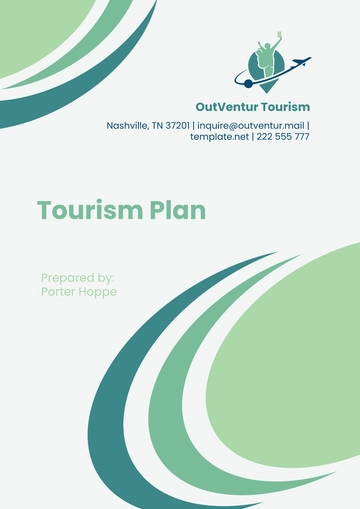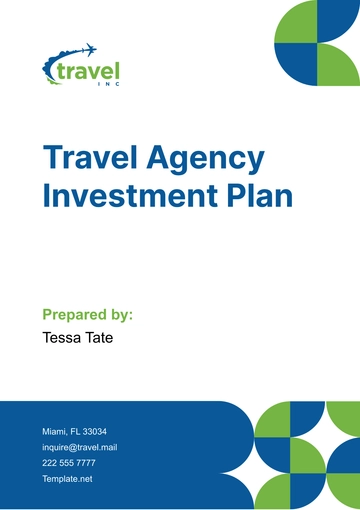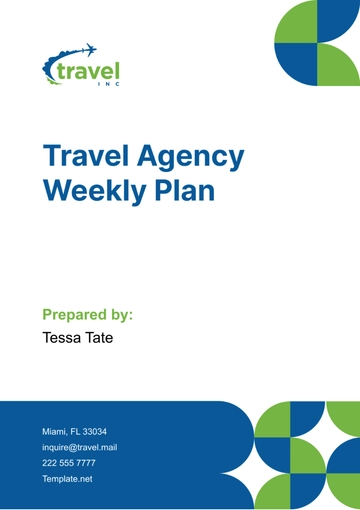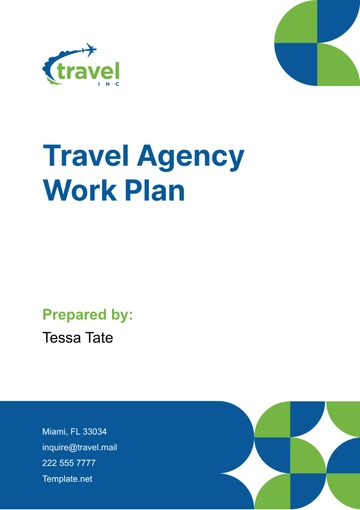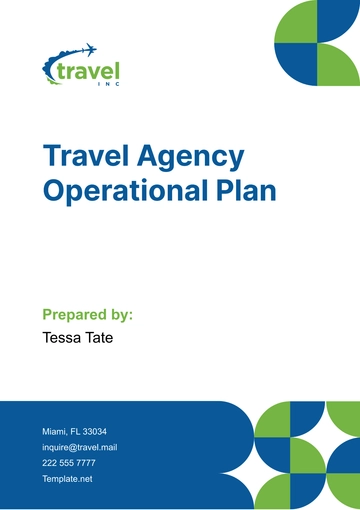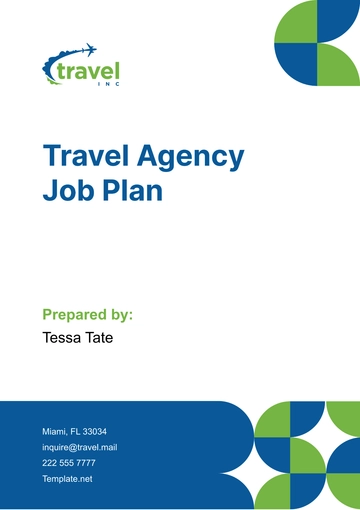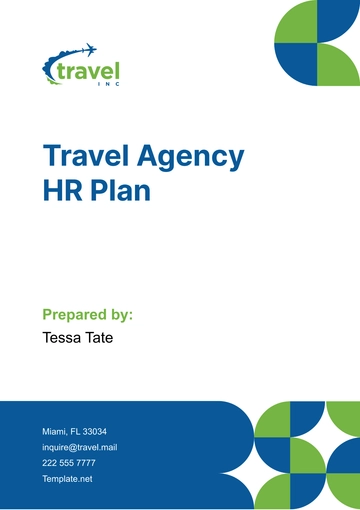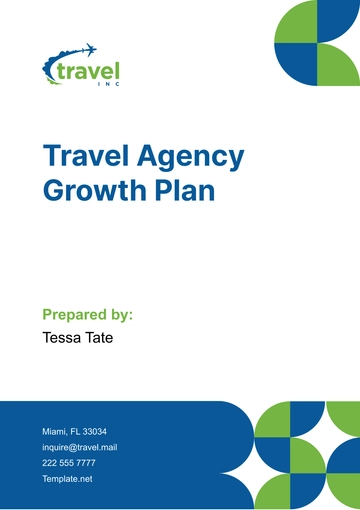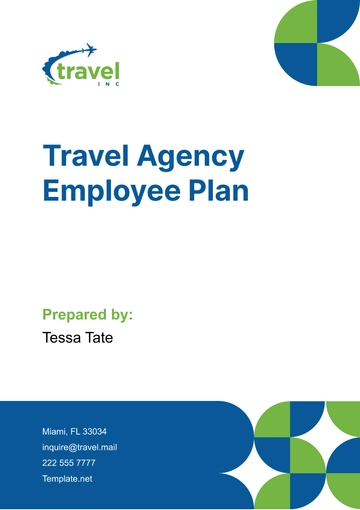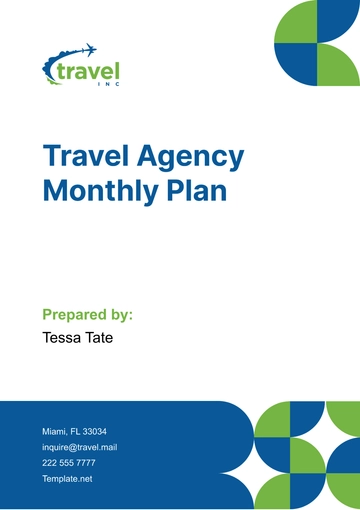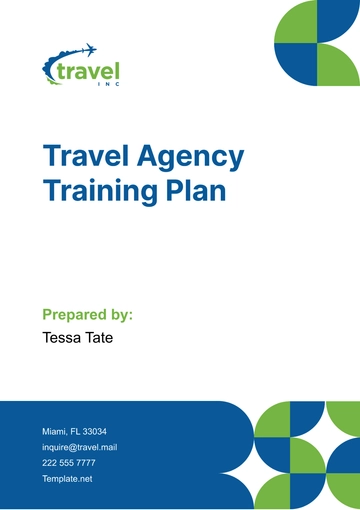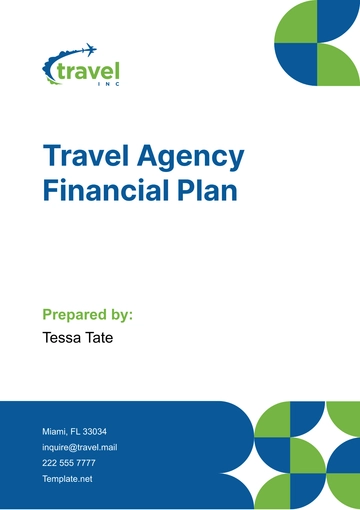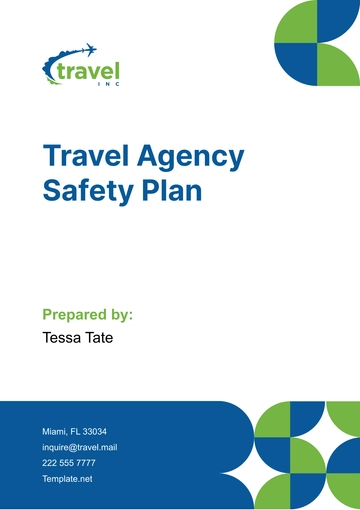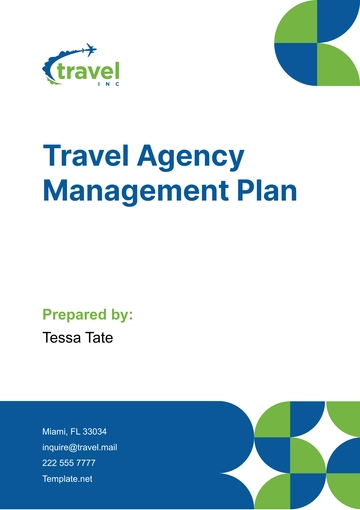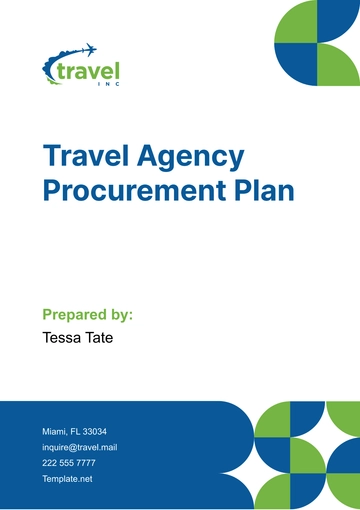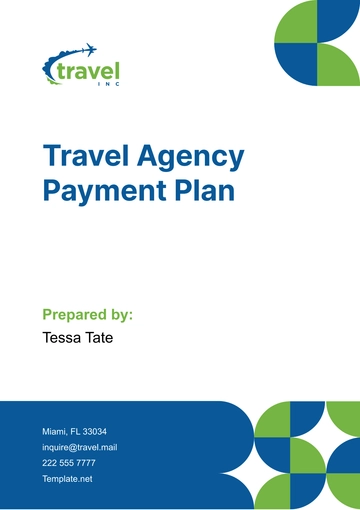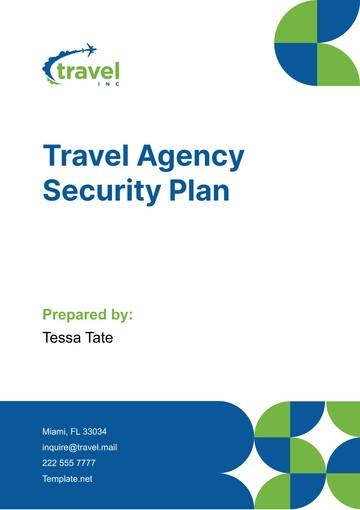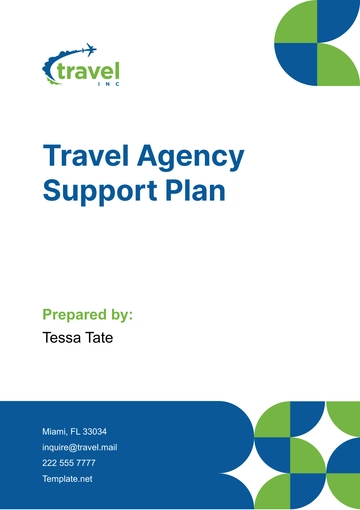Free Travel Agency Safety Plan

I. Introduction
At [Your Company Name], we are dedicated to ensuring the safety and security of our clients and staff during their travel experiences. This comprehensive Travel Agency Safety Plan reflects our commitment to providing peace of mind to all involved in our travel arrangements.
II. Risk Assessment
Risk assessment is a fundamental aspect of our safety protocol. We conduct meticulous evaluations for each destination and itinerary to identify potential hazards and threats. Here are the key items to consider:
Health Risks: During the risk assessment process, we meticulously evaluate potential health hazards that travelers may encounter, encompassing factors such as prevalent infectious diseases within the region, adherence to food safety standards across dining establishments, and environmental considerations like air quality indices and susceptibility to climate-related risks such as heatwaves or air pollution.
Safety Risks: In our comprehensive safety evaluation, we delve into various safety concerns that could impact travelers, encompassing an analysis of crime rates prevalent in the destination, the presence of terrorism threats or political unrest, and the vulnerability to natural disasters such as earthquakes, hurricanes, or wildfires, ensuring a thorough understanding of potential safety risks.
Travel Risks: Our assessment extends to transportation safety factors, encompassing an analysis of road conditions, accident rates, and the reliability of public transportation systems, providing insights into the potential risks associated with traveling within the destination and ensuring informed decision-making regarding transportation options.
Destination-Specific Risks: We meticulously identify and evaluate any unique risks associated with the specific destination, encompassing considerations such as altitude sickness in high-altitude locations, the potential for wildlife encounters in remote areas, or specific health risks prevalent in certain regions, ensuring travelers are adequately prepared for the challenges specific to their chosen destination.
Seasonal Risks: In our risk assessment process, we account for seasonal variations in risk factors that may impact traveler safety, including the onset of monsoon seasons, extreme weather events such as hurricanes or typhoons, or peak tourist seasons which may exacerbate overcrowding and associated safety concerns, ensuring travelers are aware of potential seasonal risks.
Healthcare Infrastructure Risk: As part of our comprehensive risk assessment, we evaluate the healthcare infrastructure at the destination, considering factors such as the availability and quality of healthcare facilities, access to medical care, and the availability of emergency evacuation options, ensuring travelers have access to adequate medical support and assistance in the event of unforeseen health emergencies.
III. Health and Safety Measures
Our health and safety measures are designed to mitigate risks and promote a safe travel environment. These measures include:
Provision of Personal Protective Equipment (PPE): We ensure the availability and distribution of essential PPE such as masks, hand sanitizers, and disinfectant wipes to all travelers and staff members, promoting personal hygiene and reducing the risk of viral transmission during travel.
Enhanced Cleaning and Sanitation Protocols: We implement rigorous cleaning and sanitation procedures across all touchpoints of the travel experience, including vehicles, accommodations, and public spaces, adhering to guidelines from health authorities to minimize the risk of contamination and ensure a hygienic environment for all.
Implementation of Social Distancing Measures: To mitigate the spread of infectious diseases, we enforce social distancing protocols during transportation and activities, including seating arrangements, queue management, and capacity restrictions, promoting safe interactions and reducing close contact among travelers.
Collaboration with Trusted Suppliers: We partner with reputable suppliers who uphold strict health and safety standards, ensuring that accommodations, transportation providers, and activity operators adhere to established protocols and guidelines, maintaining a consistent level of safety across all aspects of travel.
Continuous Monitoring and Adaptation: We maintain vigilant monitoring of health advisories, regulatory changes, and emerging risks, allowing us to promptly adapt our health and safety measures in response to evolving circumstances, ensuring the ongoing protection and well-being of travelers and staff members.
IV. Emergency Response Plan
A. Medical Emergencies:
Assessment: In the event of a medical emergency, assess the situation to determine the nature and severity of the medical condition.
Immediate Assistance: Provide immediate first aid or medical assistance to the affected individual, if trained to do so, while ensuring the safety of oneself and others.
Contact Emergency Services: If the situation requires professional medical attention, promptly contact local emergency services (e.g., ambulance services) and provide them with the necessary information about the location and nature of the emergency.
Coordinate Evacuation: Coordinate with emergency responders to facilitate the safe evacuation of the individual to the nearest appropriate medical facility for further treatment and care.
Communicate with Authorities: Notify relevant authorities, such as hotel or accommodation management, tour operators, and local authorities, about the medical emergency and follow their instructions as needed.
B. Natural Disasters:
Assessment: Assess the situation to determine the type and severity of the natural disaster, such as earthquakes, hurricanes, floods, or wildfires.
Evacuation: If necessary, initiate evacuation procedures to ensure the safety of travelers and staff members. Follow predetermined evacuation routes and assembly points to minimize risks.
Emergency Communication: Use all available communication channels (e.g., mobile phones, emergency radios) to relay information and instructions to travelers and staff members, keeping them informed about the situation and any evacuation procedures.
Relocation: If evacuation is not feasible, relocate travelers and staff to designated safe areas within accommodations or nearby facilities until it is safe to evacuate or return to normal activities.
Assistance and Support: Provide assistance and support to travelers and staff members, including access to essential supplies, medical care, and communication with family or emergency contacts.
C. Security Threats:
Assessment: Assess the nature and severity of the security threat, such as civil unrest, terrorism, or criminal activity, through available information sources and local authorities.
Secure Environment: Take immediate measures to secure the environment and ensure the safety of travelers and staff members, including lockdown procedures if necessary.
Communication with Authorities: Coordinate with local authorities, law enforcement agencies, and security personnel to report the security threat and receive instructions on appropriate actions to take.
Evacuation or Shelter-in-Place: Depending on the severity of the security threat, either initiate evacuation procedures to move travelers and staff to a safe location or implement shelter-in-place protocols to secure the premises and minimize exposure to potential risks.
Continuous Monitoring: Continuously monitor the situation and follow the guidance of local authorities and security personnel until the security threat has been resolved and it is safe to resume normal activities.
D. Communication Protocol:
Primary Contact Person: Designate a primary contact person or team responsible for initiating and coordinating emergency response procedures, ensuring clear communication and timely decision-making.
Emergency Contact Information: Maintain an updated list of emergency contact information for local authorities, emergency services, medical facilities, accommodations, and other relevant stakeholders.
Communication Channels: Establish primary and secondary communication channels for relaying emergency information to travelers, staff members, and relevant stakeholders, including mobile phones, emergency radios, and email.
Regular Updates: Provide regular updates and information to travelers and staff members throughout the duration of the emergency, keeping them informed about the situation, any developments, and instructions for action.
Post-Emergency Follow-Up: After the emergency has been resolved, conduct a debriefing session to review the effectiveness of emergency response procedures, identify any areas for improvement, and update the Emergency Response Plan accordingly.
E. Training and Preparedness:
Employee Training: Provide comprehensive training to all staff members on emergency response procedures, including roles and responsibilities, communication protocols, and evacuation procedures.
Mock Drills: Conduct regular mock drills and simulations to test the effectiveness of emergency response procedures, identify areas for improvement, and ensure that staff members are adequately prepared to respond to emergencies.
Emergency Kits: Maintain emergency kits or supplies containing essential items such as first aid supplies, flashlights, batteries, emergency blankets, and non-perishable food and water, to support emergency response efforts.
Emergency Contacts: Ensure that all travelers have access to emergency contact information for local authorities, emergency services, medical facilities, accommodations, and the travel agency, both before and during their travel experience.
Continuous Review and Improvement: Continuously review and update the Emergency Response Plan based on feedback, lessons learned from past emergencies, and changes in risk factors or regulations, ensuring that it remains effective and relevant.
V. Destination Information
We provide comprehensive destination information to empower our clients with knowledge and awareness. This includes:
Health Advisories: Sharing up-to-date health advisories, vaccination requirements, and recommendations from reputable sources such as the World Health Organization (WHO) and the Centers for Disease Control and Prevention (CDC).
Travel Restrictions: Communicating entry requirements, visa information, quarantine regulations, and any travel advisories or restrictions issued by government authorities.
Safety Precautions: Offering practical safety tips and advice specific to each destination, including guidance on navigating local customs and cultural norms.
VI. Travel Insurance
While travel insurance is not mandatory, we strongly recommend that our clients obtain comprehensive coverage to safeguard their investment and well-being. This includes:
Medical Coverage: Ensuring adequate medical coverage for emergency medical treatment, hospitalization, and repatriation in the event of illness or injury abroad.
Trip Cancellation/Interruption Insurance: Protecting against unforeseen circumstances that may necessitate the cancellation or interruption of travel plans, such as illness, injury, or unexpected events.
Emergency Evacuation: Providing coverage for emergency evacuation and transportation to the nearest appropriate medical facility in the event of a medical emergency or natural disaster.
VII. Continuous Monitoring
Continuous monitoring is essential for maintaining the effectiveness of our safety protocols and responding promptly to changing circumstances. This includes:
Regular Communication: Maintaining open lines of communication with local authorities, travel partners, and clients to stay informed about developments and emerging risks.
Feedback and Incident Reports: Encouraging clients and staff to report any safety concerns, incidents, or near misses to facilitate continuous improvement and learning.
Adaptive Planning: Remaining flexible and adaptable in our approach, adjusting travel itineraries and safety protocols as needed based on evolving circumstances and feedback.
VIII. Conclusion
At [Your Company Name], safety is paramount. Our Travel Agency Safety Plan reflects our unwavering commitment to ensuring the well-being of all individuals involved in our travel experiences. By prioritizing risk assessment, implementing robust safety measures, and maintaining vigilance through continuous monitoring, we strive to provide our clients with safe and secure travel experiences that they can trust and enjoy.
- 100% Customizable, free editor
- Access 1 Million+ Templates, photo’s & graphics
- Download or share as a template
- Click and replace photos, graphics, text, backgrounds
- Resize, crop, AI write & more
- Access advanced editor
Prioritize traveler safety with Template.net's Travel Agency Safety Plan Template. Editable in our AI Editor Tool, this customizable template provides a structured format for outlining safety protocols, risk management strategies, and emergency procedures for your agency. Enhance client confidence, mitigate risks, and prioritize safety with this professional template from Template.net!
You may also like
- Finance Plan
- Construction Plan
- Sales Plan
- Development Plan
- Career Plan
- Budget Plan
- HR Plan
- Education Plan
- Transition Plan
- Work Plan
- Training Plan
- Communication Plan
- Operation Plan
- Health And Safety Plan
- Strategy Plan
- Professional Development Plan
- Advertising Plan
- Risk Management Plan
- Restaurant Plan
- School Plan
- Nursing Home Patient Care Plan
- Nursing Care Plan
- Plan Event
- Startup Plan
- Social Media Plan
- Staffing Plan
- Annual Plan
- Content Plan
- Payment Plan
- Implementation Plan
- Hotel Plan
- Workout Plan
- Accounting Plan
- Campaign Plan
- Essay Plan
- 30 60 90 Day Plan
- Research Plan
- Recruitment Plan
- 90 Day Plan
- Quarterly Plan
- Emergency Plan
- 5 Year Plan
- Gym Plan
- Personal Plan
- IT and Software Plan
- Treatment Plan
- Real Estate Plan
- Law Firm Plan
- Healthcare Plan
- Improvement Plan
- Media Plan
- 5 Year Business Plan
- Learning Plan
- Marketing Campaign Plan
- Travel Agency Plan
- Cleaning Services Plan
- Interior Design Plan
- Performance Plan
- PR Plan
- Birth Plan
- Life Plan
- SEO Plan
- Disaster Recovery Plan
- Continuity Plan
- Launch Plan
- Legal Plan
- Behavior Plan
- Performance Improvement Plan
- Salon Plan
- Security Plan
- Security Management Plan
- Employee Development Plan
- Quality Plan
- Service Improvement Plan
- Growth Plan
- Incident Response Plan
- Basketball Plan
- Emergency Action Plan
- Product Launch Plan
- Spa Plan
- Employee Training Plan
- Data Analysis Plan
- Employee Action Plan
- Territory Plan
- Audit Plan
- Classroom Plan
- Activity Plan
- Parenting Plan
- Care Plan
- Project Execution Plan
- Exercise Plan
- Internship Plan
- Software Development Plan
- Continuous Improvement Plan
- Leave Plan
- 90 Day Sales Plan
- Advertising Agency Plan
- Employee Transition Plan
- Smart Action Plan
- Workplace Safety Plan
- Behavior Change Plan
- Contingency Plan
- Continuity of Operations Plan
- Health Plan
- Quality Control Plan
- Self Plan
- Sports Development Plan
- Change Management Plan
- Ecommerce Plan
- Personal Financial Plan
- Process Improvement Plan
- 30-60-90 Day Sales Plan
- Crisis Management Plan
- Engagement Plan
- Execution Plan
- Pandemic Plan
- Quality Assurance Plan
- Service Continuity Plan
- Agile Project Plan
- Fundraising Plan
- Job Transition Plan
- Asset Maintenance Plan
- Maintenance Plan
- Software Test Plan
- Staff Training and Development Plan
- 3 Year Plan
- Brand Activation Plan
- Release Plan
- Resource Plan
- Risk Mitigation Plan
- Teacher Plan
- 30 60 90 Day Plan for New Manager
- Food Safety Plan
- Food Truck Plan
- Hiring Plan
- Quality Management Plan
- Wellness Plan
- Behavior Intervention Plan
- Bonus Plan
- Investment Plan
- Maternity Leave Plan
- Pandemic Response Plan
- Succession Planning
- Coaching Plan
- Configuration Management Plan
- Remote Work Plan
- Self Care Plan
- Teaching Plan
- 100-Day Plan
- HACCP Plan
- Student Plan
- Sustainability Plan
- 30 60 90 Day Plan for Interview
- Access Plan
- Site Specific Safety Plan
